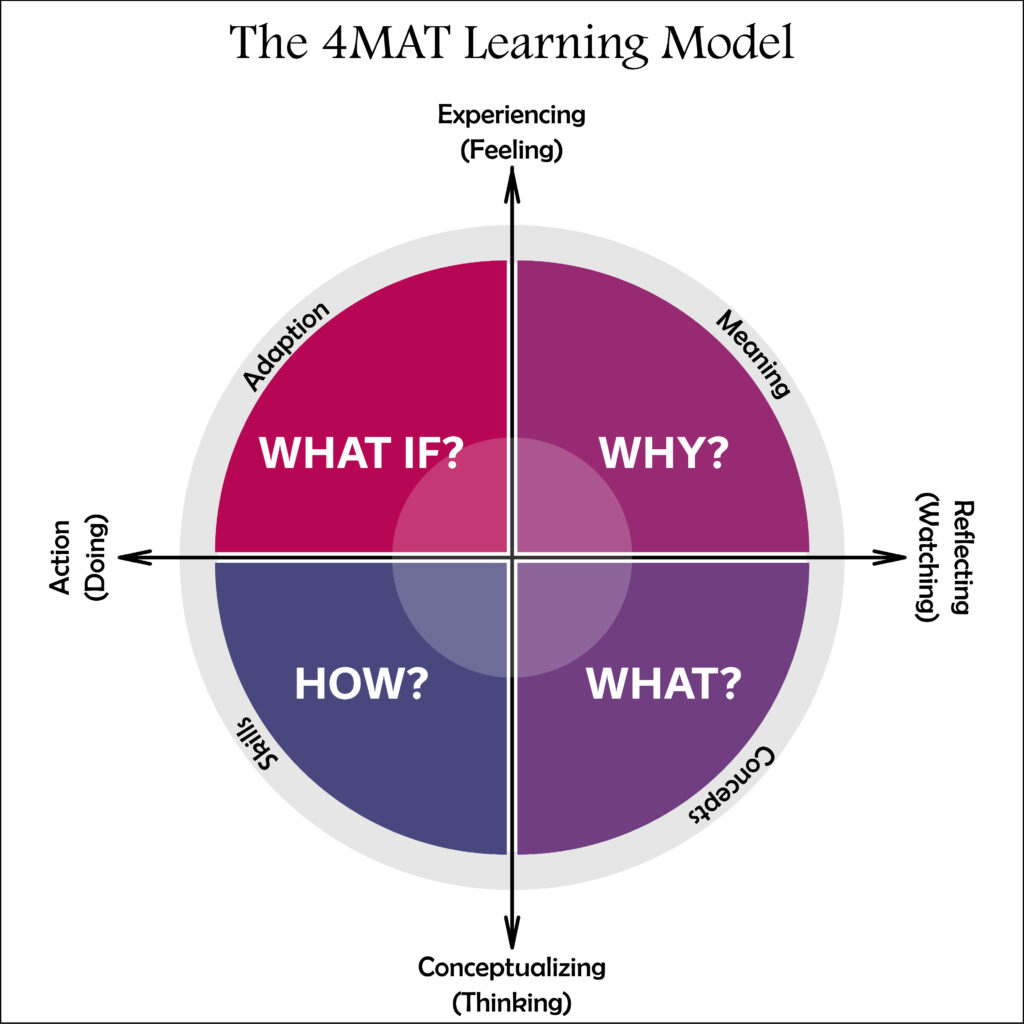Designing learning to connect with every student can be challenging. There are several frameworks that can help, but a favourite is the 4MAT model by educator Bernice McCarthy. It uses 4 questions – why, what, how, and what if – to create engagement and inclusion in learning.
This framework is so useful because it easily complements and enhances other frameworks such as Bloom’s Taxonomy, or Kolb’s Learning Cycle, while easily absorbing learning theory such as Knowles’ Adult Learning Theory, and Constructivism.
Why is using a learning framework important?
It’s about engagement and making life easier. The 4MAT model offers a structured way to think about how people are taking on the information, and how they will process it. It recognises that students learn in different ways – some want meaning, some prefer structure, others need to experiment, and so on. Structuring your material around this framework also means the material will naturally be covered from different angles, and therefore you’re more likely to create engagement.
4MAT gives you a way to shape your sessions around how people learn, not just what you want to say. It’s flexible, adaptable across disciplines, and helps keep your teaching balanced – not too content-heavy, not too activity-driven.
When creating your lecture, start by asking why students should care about the topic. You might see this relating to the ‘remember’ and ‘understand’ levels in Bloom’s Taxonomy, as this is where you can emphasise the relevance and connect to current knowledge.
What is the 4MAT framework?
4MAT offers a way to design learning experiences that break down a learning cycle into 4 phases:
- Why? Connect the information to experiences that give meaning and real-world relevance.
- What? Conceptualise the information.
- How? Extend the information and practice using it.
- What if? Add nuance to the information and refine the details.
These are laid out via the intersection of two spectrums. On the vertical, you have experiencing against conceptualising. This is feeling vs thinking. On the horizontal, you have acting against reflecting or doing vs watching. We all move along both these lines at various times, depending on external and internal factors including the content, context, our mood, and motivations, among other things.
As you flow through your lecture, ideally you’ll end up back at the start, with a new ‘why’.

The 4MAT model also respects that people prefer different parts of this cycle and allows the content to be tailored in multiple ways. It’s like saying it provides a map as well as a compass – the framework of a learning cycle, and the questions to get you through it.
How could you use this to structure your next lecture?
Design your content so you’re answering the 4 questions:
- Why should students care about this? Include a short case study, story, anecdote or problem statement.
- What do they need to understand? Use definitions, facts, share the basic concepts.
- How can they try it out? Bring in a simulation, discussion, pair/peer work, or other activities.
- What could they do with it? Change the scenario – come back to your opening statement and change it up. Throw in some ‘what if’ questions: what if x, how would that change your answer? Link back to why – why does your answer change?
Consider which parts need to be done in class, which can be done asynchronously, what needs discussion, what can be a video, a Mentimeter activity or Miro board. Maybe a knowledge check quiz is used as a learning tool, or other method that aligns with Bloom’s ‘analyse’ and ‘apply’ levels.
If you’re using the framework, consider what might change…
Each lesson would connect to students in a meaningful way with a strong context (why), followed by knowledge (what) along with practice (how) and innovation or challenges (what if). You’re less likely to leave someone behind, covering all bases for people preferring concrete experience, or analytical thinking, people who like to apply the information and people who prefer imaginative exploration. You can also make space for stretch thinking such as Bloom’s ‘evaluate’ and ‘create’ levels.
It can take a little bit of time initially to switch to thinking like this, but it makes for a richer experience overall. Using this framework makes learning more effective, inclusive and engaging. It recognises that students are learning in different ways at different times, and accounts for that seamlessly. By intentionally designing lessons around the four questions of why, what, how, and what if, you can connect theory to practice, motivate deeper learning and engagement, and support diverse needs. In short, it helps make learning ‘sticky’!
If you’re wondering how this looks in practice, scan this article again. Can you see where the sections align with the 4 questions?
